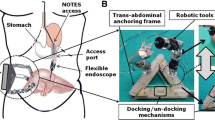Abstract
Background
Laparoendoscopic single-site surgery and natural orifice transluminal endoscopic surgery attempt to reduce transabdominal port sites. These require all instruments to pass through a single access point, leading to instruments collide or work at unfamiliar angles. Thus, we designed an internal grasper under magnetic anchoring guide system (MAGS) platform and investigated its utility and operability.
Methods
We measured the configuration for magnetic force decay over distance using a standardized, ex vivo laboratory testing apparatus. An electronic balance was used to measure the force of the gallbladder pull in ten patients with gallbladder stones. One pig (11 mm abdominal wall thickness) underwent a compressed trial of MAGS platform. The device was left in place for 20 min before tissue sections were harvested, and histologic assessment was performed. The utility and operability were investigated in four pigs (38–280 kg weight).
Results
The magnetic attraction force decayed exponentially over distance; the force of pulling gallbladder was 7.46 ± 0.54 N. This pairing of components allowed for coupling to a theoretical distance of 10 mm. No gross tissue damage was observed. H–E stain showed no necrosis in all specimens. One failed due to wall thickness of 45 mm. Others showed the critical view, triangulation of instruments was obtained, and instrument collision or “sword fighting” was reduced.
Conclusions
The MAGS platform overcomes limitations such as collisions and lack of triangulation, reduces transabdominal port sites, and is easy to operate. However, our internal grasper requires the abdominal wall thickness below 10 mm.





Similar content being viewed by others
References
Haber GP, Autorino R, Laydner H, Yang B, White MA, Hillyer S, Altunrende F, Khanna R, Spana G, Wahib I, Fareed K, Stein RJ, Kaouk JH (2012) SPIDER surgical system for urologic procedures with laparoendoscopic single-site surgery: from initial laboratory experience to first clinical application. Eur Urol 61:415–422
Park S, Bergs RA, Eberhart R, Baker L, Fernandez R, Cadeddu JA (2007) Trocar-less instrumentation for laparoscopy: magnetic positioning of intra-abdominal camera and retractor. Ann Surg 245:379–384
Zeltser IS, Bergs R, Fernandez R, Baker L, Eberhart R, Cadeddu JA (2007) Single trocar laparoscopic nephrectomy using magnetic anchoring and guidance system in the porcine model. J Urol 178:288–291
Scott DJ, Tang SJ, Fernandez R, Bergs R, Goova MT, Zeltser I, Kehdy FJ, Cadeddu JA (2007) Completely transvaginal NOTES cholecystectomy using magnetically anchored instruments. Surg Endosc 21:2308–2316
Scott D, Tang S, Goova M, Bergs R, Hogg D, Kehdy F, Cadeddu J, Fernandez R (2007) Short-term survival outcomes following transvaginal NOTES cholecystectomy using magnetically anchored instruments. Gastrointest Endosc 65:AB109
Scott D, Tang S, Goova M, Bergs R, Kehdy F, Hogg D, Hollett L, Olukoga C, Gedeon M, Cadeddu J (2008) Optimizing magnetically anchored camera, light source, graspers, and cautery dissector for transvaginal NOTES cholecystectomy. Surg Endosc 22:S244
Scott DJ, Tang SJ, Bergs R, Olukoga CO, Paramo J, Hogg DC, Fernandez R (2008) Transvaginal single access “pure” NOTES sleeve gastrectomy using a deployable magnetically anchored video camera. Gastrointest Endosc 67:AB116–AB117
Raman JD, Scott DJ, Cadeddu JA (2009) Role of magnetic anchors during laparoendoscopic single site surgery and NOTES. J Endourol 23:781–786
Cadeddu J, Fernandez R, Desai M, Bergs R, Tracy C, Tang S-J, Rao P, Desai M, Scott D (2009) Novel magnetically guided intra-abdominal camera to facilitate laparoendoscopic single-site surgery: initial human experience. Surg Endosc 23:1894–1899
Raman JD, Bergs RA, Fernandez R, Bagrodia A, Scott DJ, Tang SJ, Pearle MS, Cadeddu JA (2009) Complete transvaginal NOTES nephrectomy using magnetically anchored instrumentation. J Endourol 23:367–371
Mashaud LB, Kabbani W, Caban A, Best S, Hogg DC, Cadeddu JA, Bergs R, Beardsley H, Fernandez R, Scott DJ (2011) Tissue compression analysis for magnetically anchored cautery dissector during single-site laparoscopic cholecystectomy. J Gastrointest Surg 15:902–907
Arain NA, Cadeddu JA, Best SL, Roshek T, Chang V, Hogg DC, Bergs R, Fernandez R, Webb EM, Scott DJ (2012) A randomized comparison of laparoscopic, magnetically anchored, and flexible endoscopic cameras in performance and workload between laparoscopic and single-incision surgery. Surg Endosc 26:1170–1180
Mashaud LB, Kabbani W, Caban A, Best S, Hogg DC, Cadeddu JA, Bergs R, Beardsley H, Fernandez R, Scott DJ (2011) Tissue compression analysis for magnetically anchored cautery dissector during single-site laparoscopic cholecystectomy. J Gastrointest Surg 15:902–907
Joseph RA, Salas NA, Donovan MA, Reardon PR, Bass BL, Dunkin BJ (2012) Single-site laparoscopic (SSL) cholecystectomy in human cadavers using a novel percutaneous instrument platform and a magnetic anchoring and guidance system (MAGS): reestablishing the “critical view”. Surg Endosc 26:149–153
Best SL, Bergs R, Gedeon M, Paramo J, Fernandez R, Cadeddu JA, Scott DJ (2011) Maximizing coupling strength of magnetically anchored surgical instruments: how thick can we go? Surg Endosc 25:153–159
Best SL, Kabbani W, Scott DJ, Bergs R, Beardsley H, Fernandez R, Mashaud LB, Cadeddu JA (2011) Magnetic anchoring and guidance system instrumentation for laparo-endoscopic single-site surgery/natural orifice transluminal endoscopic surgery: lack of histologic damage after prolonged magnetic coupling across the abdominal wall. Urology 77:243–247
Acknowledgments
This work was supported by a grant from the Ministry of Education Innovation Team Development Program of China (No. IRT1279, YL) and a grant from the Shaanxi Province science and technology resource integrated program (No. 2016TZC-G-5-6, RW).
Author information
Authors and Affiliations
Corresponding author
Ethics declarations
Disclosures
Yafei Shang, Hongjun Guo, Da Zhang, Fei Xue, Xiaopeng Yan, Aihua Shi, Dinghui Dong, Shanpei Wang, Feng Ma, Haohua Wang, Jianhui Li, Xuemin Liu, Ruixue Luo, Rongqian Wu, Yi Lv declared that they have no conflict of interest.
Rights and permissions
About this article
Cite this article
Shang, Y., Guo, H., Zhang, D. et al. An application research on a novel internal grasper platform and magnetic anchoring guide system (MAGS) in laparoscopic surgery. Surg Endosc 31, 274–280 (2017). https://doi.org/10.1007/s00464-016-4968-9
Received:
Accepted:
Published:
Issue Date:
DOI: https://doi.org/10.1007/s00464-016-4968-9



